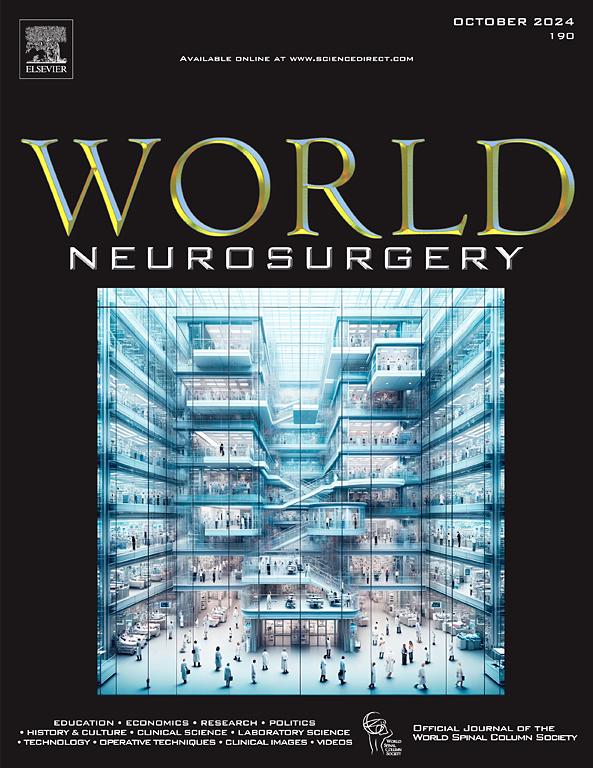Tailored Callosotomy in Third Ventricle Colloid Cyst Resection via Anterior Interhemispheric Transcallosal Approach
IF 1.9
4区 医学
Q3 CLINICAL NEUROLOGY
引用次数: 0
Abstract
Background
The colloid cyst represents a relatively uncommon intracranial lesion. It garners significant attention from neurosurgeons due to its benign nature, deep-seated location, and promising prognosis when identified early and surgically removed. A variety of surgical methods are used to treat these cysts, each with their strengths and weaknesses. The aim of this study is to introduce and assess a precise microsurgical technique for managing colloid cysts using the anterior interhemispheric transcallosal approach.
Methods
The research involved a retrospective analysis of 14 cases between 2021 and 2023 treated with the anterior interhemispheric transcallosal approach by 2 experienced skull base surgeons. The evaluation encompassed demographic, clinical, radiological, histological, and surgical data. Additionally, the colloid cyst risk score was used to assess the risk of obstructive hydrocephalus. The procedure incorporated neuronavigation and ultrasound to determine the precise entry point and to plan the trajectory.
Results
The minimally invasive microsurgical technique was effectively employed in all 14 cases, with no reported postoperative complications. Postsurgery magnetic resonance imaging scans confirmed complete cyst removal, with an average callosotomy measurement of 5.4 ± 2.5 mm. Importantly, none of the patients experienced disconnection syndrome associated with callosotomy.
Conclusions
The adapted microsurgical approach via the anterior interhemispheric transcallosal method emerges as a secure and efficient way to address colloid cysts. It ensures comprehensive cyst removal while minimizing complications, boasting advantages such as reduced invasiveness, enhanced visibility, and minimal tissue disturbance, thereby confirming its role in colloid cyst surgical interventions.
胼胝体切开术经前半球间经胼胝体入路治疗第三脑室胶质囊肿。
背景:胶体囊肿是一种相对罕见的颅内病变。由于其良性,深层位置,早期发现和手术切除预后良好,因此引起了神经外科医生的极大关注。治疗这些囊肿的手术方法多种多样,各有优缺点。目的:本研究的目的是介绍和评估采用前半球间经胼胝体入路治疗胶质囊肿的精确显微外科技术。方法:回顾性分析两名经验丰富的颅底外科医生在2021年至2023年期间采用前半球间经胼胝体入路治疗的14例病例。评估包括人口统计学、临床、放射学、组织学和外科数据。此外,胶体囊肿风险评分(CCRS)用于评估梗阻性脑积水的风险。该过程结合了神经导航和超声波来确定精确的进入点和规划轨迹。结果:14例患者均有效应用微创显微手术技术,无术后并发症报道。术后MRI扫描证实囊肿完全切除,胼胝体切开术平均测量5.4±2.5 mm。重要的是,没有患者经历与胼胝体切开术相关的断开综合征。结论:经前半球间经胼胝体方法的显微外科手术是一种安全有效的治疗胶体囊肿的方法。它既能保证囊肿的全面切除,又能最大限度地减少并发症,具有侵袭性小、可见度高、对组织干扰小等优点,从而证实了它在胶体囊肿手术干预中的作用。
本文章由计算机程序翻译,如有差异,请以英文原文为准。
求助全文
约1分钟内获得全文
求助全文
来源期刊

World neurosurgery
CLINICAL NEUROLOGY-SURGERY
CiteScore
3.90
自引率
15.00%
发文量
1765
审稿时长
47 days
期刊介绍:
World Neurosurgery has an open access mirror journal World Neurosurgery: X, sharing the same aims and scope, editorial team, submission system and rigorous peer review.
The journal''s mission is to:
-To provide a first-class international forum and a 2-way conduit for dialogue that is relevant to neurosurgeons and providers who care for neurosurgery patients. The categories of the exchanged information include clinical and basic science, as well as global information that provide social, political, educational, economic, cultural or societal insights and knowledge that are of significance and relevance to worldwide neurosurgery patient care.
-To act as a primary intellectual catalyst for the stimulation of creativity, the creation of new knowledge, and the enhancement of quality neurosurgical care worldwide.
-To provide a forum for communication that enriches the lives of all neurosurgeons and their colleagues; and, in so doing, enriches the lives of their patients.
Topics to be addressed in World Neurosurgery include: EDUCATION, ECONOMICS, RESEARCH, POLITICS, HISTORY, CULTURE, CLINICAL SCIENCE, LABORATORY SCIENCE, TECHNOLOGY, OPERATIVE TECHNIQUES, CLINICAL IMAGES, VIDEOS
 求助内容:
求助内容: 应助结果提醒方式:
应助结果提醒方式:


